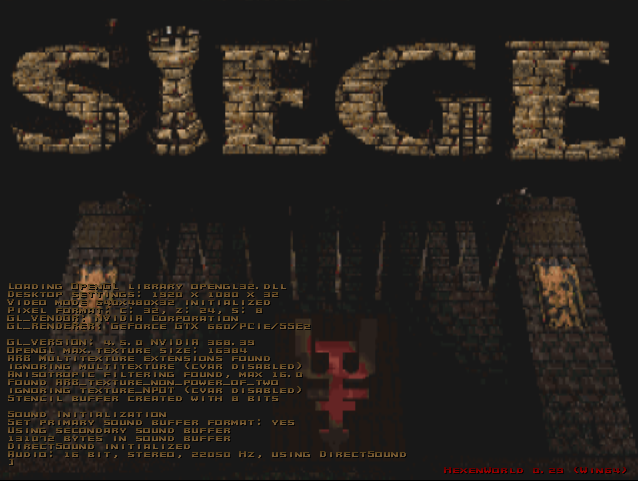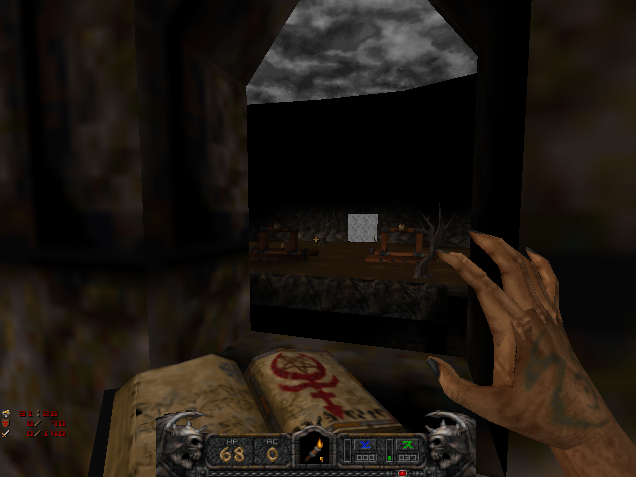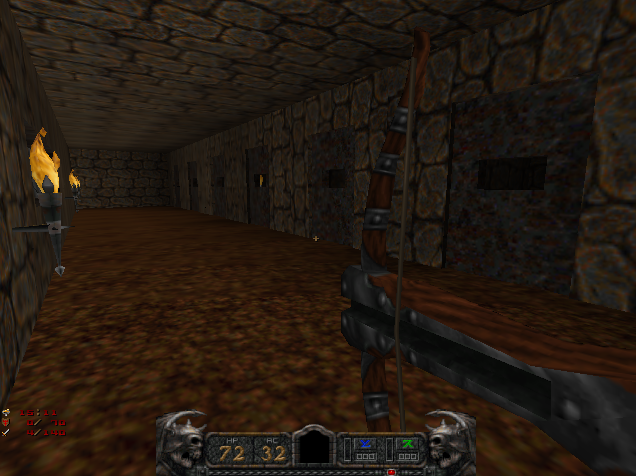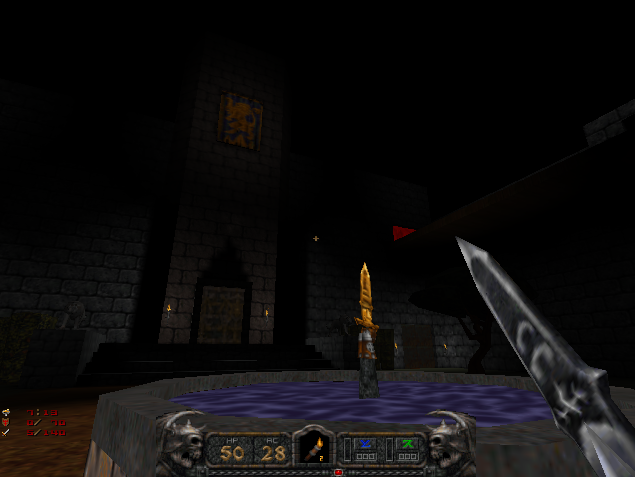Hexen II's forgotten multiplayer mod Siege was the most ambitious shooter of the 90s
Siege's deep classes and intricate maps offered more strategy, and required tighter teamwork, than most of today's shooters.

In the summer of 1998, I was stuck indoors. My best friend had broken his leg, and so we resolved to beat the hardest video games either of us had ever played: Hexen: Beyond Heretic and its just-released sequel Hexen II. We beat both that summer and got pretty good at Deathmatch to boot. Since it was the days of dial-up, we spent our limited online time gaming and read very little about what was, at the time, a thriving mod community for games based on Quake’s engine. One mod for HexenWorld I remember was Siege—it sounded too good to be true, but at a whopping 8.21 megabytes there was no way we’d ever spend the time to get it. We just had to read what was being written by its breathless fans and dream.
In retrospect, that’s a damn shame. I recently hijacked a local LAN weekend to indulge my nostalgic curiosity. We played Siege and found an ambitious mod project years ahead of the curve, which feels like it could have followed a modern developer’s playbook: A team-based, class-based FPS where interlocking team composition is key to victory. Complicated maps require the coordination of multiple team members to accomplish varied objectives. Deploying limited, often timed, resources at the perfect moment is vital.

Each class in Siege had an array of weapons and spells which unlocked as you accrued mana in a match, picked up ammo, and as the map’s timer ticked down. Melee classes like Paladins and Dwarves don’t have spells, but their swords, axes, or hammers are specialty tools—the Paladin’s sword can decapitate foes with a headshot, while the Dwarf’s hammer and axe are the best digging and smashing tools there are.
Specialists like the Assassin and Succubus have stronger ranged skills, but weak health and armor—but they trade those for powerful benefits. The Assassin is invisible in dark areas if she's not attacking, and can climb sheer walls. The Succubus can glide if they leap, and can save up mana for a spell that gives flight. The Cleric and Necromancer are tough and weak respectively, but lack constant versatility—aside from their spellcasting. Spells are outrageous and varied, from the predictable heal and magic missiles to a suicidal instant kill, summoned imps, server-breaking speed boosts, and transformation into a gigantic, nigh-unstoppable beast.
It’s the kind of moment-in-time idea that only came out of the open source engine that ran both Hexen and Quake.
I’m not sure what was more ambitious about Siege: the capabilities of the player classes or the sheer amount of strategic depth on a Siege map. The idea of varied classes with different powers that gain experience and heavily rely on teamwork was about a year ahead of its mainstream debut in Team Fortress in 1999, but TF mostly focused on standard gameplay modes. Siege's maps themselves, though, prefigure highly strategic objective-based shooters like Natural Selection or Return to Castle Wolfenstein: Enemy Territory—games that wouldn’t show up for four or five more years.
Siege is the kind of mad mishmash of ideas that you see from the past’s idiosyncratic modders, ideas we now typically get through modern indie developers. It’s the kind of moment-in-time idea that only came out of the open source engine that ran both Hexen and Quake. Hell, between its fantasy combat and strategic emphasis, I’m not sure we’ve gotten anything like it since.

How a round of Hexen: Siege worked
Here’s how Siege’s default map goes: Attackers and defenders use catapults and ballistae to harass each other. They cut tunnels behind the walls, swim the moat, and launch surprise attacks on the parapets. Infiltrators can sneak in to open gates, or sneak out to capture attackers and imprison them. Once the drawbridge chains are destroyed, forcing it down permanently, attackers assault the gate and portcullis. Perhaps a Necromancer turns into a giant beast, shaking the ground and pounding the gate to dust. But it’s not that easy. The inside is a maze of locked doors and elevators, with courtyards separated by teleporter doors and lined with shooting galleries.
The biggest gaming news, reviews and hardware deals
Keep up to date with the most important stories and the best deals, as picked by the PC Gamer team.
As soon as they get in, attackers have a first priority: Jailbreaks. Defenders have a magic item that sends attackers to a locked prison cell with a destructible door. Teammates can jailbreak you with some dedication, but depending on the map that can be hard. A lucky Paladin or Dwarf has the right weapon to bash their way out in about three minutes, but a Necromancer is, frankly, screwed. Go get a drink. Imagine if a modern FPS put you in a do-nothing box for the duration of an entire Overwatch match.

This is a fantasy game, with swords, bows, and arrows. Close combat is fast-paced and requires intense reflexes. Overextending by even a few feet gets you killed. Attackers must dodge the defenders’ harassment, locate a hidden key on one of their enemies, and scale a tower to the throne room. Meanwhile, the defenders gain a super-powered hero twice as fast and strong as any other player, but opening a door to go out and fight can let attackers in.
With the throne room finally open, the offense make a last gamble to touch the crown for an instant victory. Hopefully the defenders haven’t bled them too badly, because both sides are dealing with a limited number of spawns before it’s over. Maybe they’ve got a last-ditch Crusader on a suicide mission, exploding into gibs as he calls down lightning to instantly kill every attacker he can see.
It takes a hell of a lot of strategy to coordinate all of that—and good strategy too. Attackers can go for a tunnel gambit, but defenders can get down there and stalemate you if you don’t keep them on their toes at the walls. Defenders can coordinate and destroy your catapults, leaving you with only a handful of options to get inside. (They nearly all involve a flying Succubus.) Defenders can mount a surprise melee charge—complete, in a LAN at least, with screaming battle cries—and push you back to your start room for a glorious minute or so of spawn camping.
Attackers can get a sneaky Assassin past the gates, drop the bridge, and take the courtyard before the Defenders can get their act together. It’s a whirlwind that relies on coordination first and individual skill second.

These are all the things I learned playing a nearly 20-year-old mod for a few hours. Having a LAN setup meant I didn’t need to deal with the vagaries of networking or jerks who drop on purpose, but that didn’t change much. Siege has things that would have blown my mind in 1998, and still do, a little, today. Weird, lovable, and ambitious. It’s a class-based FPS with a fantastically complicated, deeply strategic flow of play. Sure, it has imperfections, but if you compare what a modern shooter like Overwatch asks players to do—escort a payload, hold a point—to what Siege does? No comparison to be made. Siege is cooler every time.
If you get the bug to bring Siege back for a few days, you can put it together using the files from a purchased copy of Hexen 2 and the open source Hexen II: Hammer of Thyrion and HexenWorld project, plus a little Quake-era command line knowhow. You probably haven’t done this for a long time, if at all, but you’ll need to read the ReadMe files to get everything going. Running it is as simple as using Run to launch “glhwcl.exe -game siege” once you’ve got it all installed. Getting a server set up is a little more complex, but the Internet Archive has preserved Siege’s number one fan site. That has a guide to getting it running and some more detailed information on the game, and is as charming a look back at gaming in 1999 as Siege itself.
Jon Bolding is a games writer and critic with an extensive background in strategy games. When he's not on his PC, he can be found playing every tabletop game under the sun.

